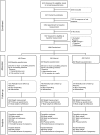Phone and e-mail counselling are effective for weight management in an overweight working population: a randomized controlled trial
- PMID: 19134171
- PMCID: PMC2667416
- DOI: 10.1186/1471-2458-9-6
Phone and e-mail counselling are effective for weight management in an overweight working population: a randomized controlled trial
Abstract
Background: The work setting provides an opportunity to introduce overweight (i.e., Body Mass Index >or= 25 kg/m2) adults to a weight management programme, but new approaches are needed in this setting. The main purpose of this study was to investigate the effectiveness of lifestyle counselling by phone or e-mail on body weight, in an overweight working population. Secondary purposes were to establish effects on waist circumference and lifestyle behaviours, and to assess which communication method is the most effective.
Methods: A randomized controlled trial with three treatments: intervention materials with phone counselling (phone group); a web-based intervention with e-mail counselling (internet group); and usual care, i.e. lifestyle brochures (control group). The interventions used lifestyle modification and lasted a maximum of six months. Subjects were 1386 employees, recruited from seven companies (67% male; mean age 43 (SD 8.6) y; mean BMI 29.6 (SD 3.5) kg/m2). Body weight was measured by research personnel and by questionnaire. Secondary outcomes fat, fruit and vegetable intake, physical activity and waist circumference were assessed by questionnaire. Measurements were done at baseline and after six months. Missing body weight was multiply imputed.
Results: Body weight reduced 1.5 kg (95% CI -2.2;-0.8, p < 0.001) in the phone group and 0.6 kg (95% CI -1.3; -0.01, p = 0.045) in the internet group, compared with controls. In completers analyses, weight and waist circumference in the phone group were reduced with 1.6 kg (95% CI -2.2;-1.0, p < 0.001) and 1.9 cm (95% CI -2.7;-1.0, p < 0.001) respectively, fat intake decreased with 1 fatpoint (1 to 4 grams)/day (95% CI -1.7;-0.2, p = 0.01) and physical activity increased with 866 METminutes/week (95% CI 203;1530, p = 0.01), compared with controls. The internet intervention resulted in a weight loss of 1.1 kg (95% CI -1.7;-0.5, p < 0.001) and a reduction in waist circumference of 1.2 cm (95% CI -2.1;-0.4, p = 0.01), in comparison with usual care. The phone group appeared to have more and larger changes than the internet group, but comparisons revealed no significant differences.
Conclusion: Lifestyle counselling by phone and e-mail is effective for weight management in overweight employees and shows potential for use in the work setting.
Trial registration: ISCRTN04265725.
Figures


References
-
- Statistics Netherlands. Statistisch Jaarboek 2008 [Statistical Yearbook 2008] Statistics Netherlands, Voorburg/Heerlen; 2008.
-
- Clinical Guidelines on the Identification, Evaluation, and Treatment of Overweight and Obesity in Adults – The Evidence Report. National Institutes of Health. Obes Res. 1998;6:51S–209S. - PubMed
Publication types
MeSH terms
LinkOut - more resources
Full Text Sources

